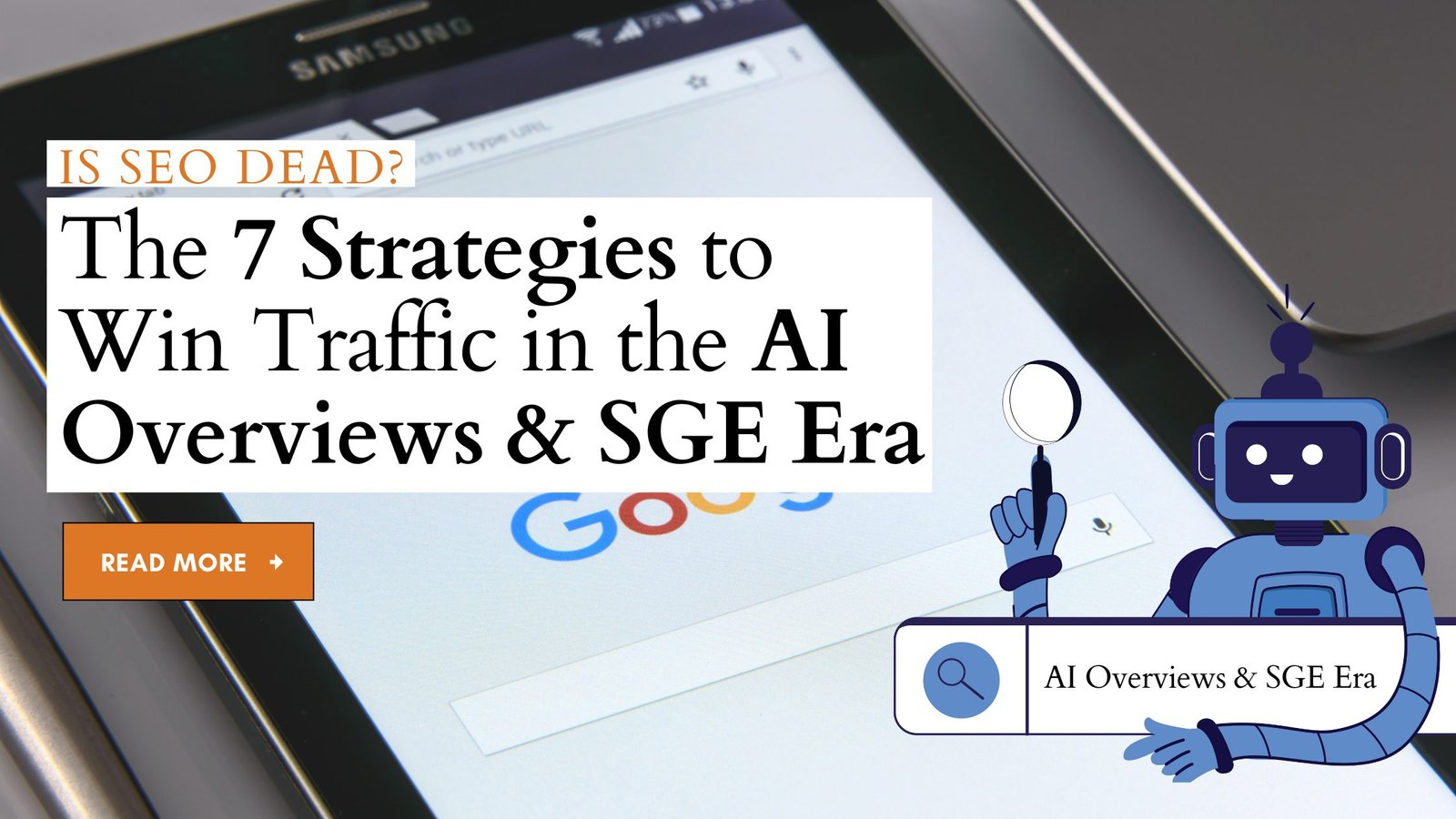
The truth is, SEO isn’t dead, it’s evolving.
What worked in 2015 no longer moves the needle in 2025. Keyword stuffing, spammy backlinks, and over-optimized titles are gone. Today, the key to ranking and driving traffic lies in authentic expertise, generative optimization, and AI-ready strategies.
If you’re a brand or business looking to dominate the digital space and partner with the best digital marketing in Mumbai, this guide will help you understand exactly how SEO works in the age of AI — and what you can do to thrive.
AI vs SEO
For years, Search Engine Optimization (SEO) was the backbone of online visibility. Businesses optimized keywords, built backlinks, and published blogs to appear on Google’s first page. But now, AI-driven search results like Google’s AI Overviews and Bing’s Copilot are reshaping how information is delivered.
Instead of showing 10 blue links, Google now answers your query directly using AI summaries.
This means:
- Users may not need to click on your website.
- Traffic sources are changing.
- Traditional SEO alone can’t guarantee visibility.
However, this doesn’t mean SEO is obsolete. It means we’re entering a new era — one where AI and SEO work together. Businesses must optimize not just for search engines, but for Generative Engines — like Google’s SGE.
The Shift: SEO → GEO (Generative Engine Optimization)
The next evolution of SEO is GEO — Generative Engine Optimization.
GEO focuses on training AI systems (like Google SGE, ChatGPT, and Bing Copilot) to understand your content and brand as a trusted, expert source.
Here’s what that means:
- Structured Data: Add schema to help AI interpret your content precisely.
- Topical Depth: Cover every related subtopic so AI models reference you as an authority.
- Trust Signals: Include author credentials, company details, testimonials, and case studies.
- Conversational Relevance: Use natural, question-answer language to align with generative summaries.
At Webtric, our SEO experts in Mumbai are already optimizing client websites for GEO, ensuring your business stays visible even when AI Overviews dominate search results.
How SGE Works:
SGE (Search Generative Experience) is Google’s AI-powered system that gives summarized answers at the top of search results.
Here’s how it works:
- A user types a query (like “best bespoke tailor in Mumbai” or “how to increase local SEO ranking”).
- Google’s AI model analyzes millions of indexed web pages, knowledge graphs, and trustworthy data sources.
- It then generates a conversational summary, pulling in references from authoritative websites.
If your brand’s content matches Google’s E-E-A-T standards — Experience, Expertise, Authoritativeness, and Trustworthiness — it can get cited inside these AI Overviews, even without ranking first traditionally.
That’s why E-E-A-T is more important than ever.
E-E-A-T: The New Core of SEO
To win in the AI-driven era, your content must prove its Experience, Expertise, Authoritativeness, and Trustworthiness — the same principles Google uses for ranking and AI citations.
| Pillar | What It Means | How to Implement |
| Experience | Real, hands-on knowledge | Add case studies, project results, and first-hand data |
| Expertise | Subject mastery | Include author bios, certifications, and niche depth |
| Authoritativeness | Industry recognition | Earn mentions from credible sites and directories |
| Trustworthiness | Transparency & accuracy | Show reviews, contact info, and secure site (HTTPS) |
At Webtric, we combine these four pillars with AI-driven SEO tools to ensure that your website ranks higher and maintains brand trust across all search and generative platforms.
Google AI Overviews Impact on SEO and What You Can Do
The rollout of AI Overviews has changed three key things about SEO:
- Reduced Click-Through Rates: Users might find answers within the AI summary itself.
- Higher Emphasis on Credibility: Google references only the most trusted websites.
- Shift Toward Conversational Queries: People now ask natural questions, not keyword phrases.
So how can you adapt?
✅ Build long-form, authoritative content that AI models can quote.
✅ Focus on semantic relevance — use natural questions and context-based answers.
✅ Implement schema markup (FAQ, Article, Product, and Local Business).
✅ Keep content updated regularly with fresh insights and unique data.
These steps help AI recognize your brand as a topical authority, which directly influences whether your website appears in AI Overviews.
6 Expert Strategies to Thrive in the Age of AI Overviews
1. Optimize for Conversational Intent (Not Just Keywords)
Instead of writing for “SEO tools Mumbai,” focus on how real people ask questions — like:
“What are the best digital marketing tools for small businesses in Mumbai?”
Use FAQs, long-tail phrases, and question-based headings to make your content more discoverable by AI.
💡 Pro Tip: Include conversational triggers like “Here’s what you can do,” “Let’s explore,” and “Step-by-step.”
2. Become the Topical Authority with Content Clusters
Google and AI models prioritize websites that fully cover a topic. Build content clusters instead of isolated blogs.
For example:
If your main keyword is best digital marketing in Mumbai, create clusters around:
- Local SEO in Mumbai
- PPC strategies for small businesses
- Content marketing trends 2025
- Google Ads vs Meta Ads performance
Internally link them to show topic mastery a proven GEO strategy.
3. Strengthen On-Page Experience
User experience now influences both SEO and AI Overviews.
Make sure your site has:
- Fast loading (under 2.5 seconds)
- Clear structure and mobile responsiveness
- Scroll-depth tracking for engagement
- Author information and trust badges
AI evaluates engagement metrics to decide which sites deserve citation.
4. Leverage Multimedia Content
SGE prefers multi-format content — articles, videos, carousels, and infographics.
Embed short explainer videos, carousel graphics, or AI-generated visuals within your content to keep users engaged longer.
5. Use Structured Data for AI Understanding
Structured data helps AI Overviews “read” your content. Add:
- FAQ Schema for question-based queries
- HowTo Schema for step guides
- Article Schema for blogs
- Local Business Schema for ranking locally
This is one of the most overlooked yet powerful GEO techniques.
6. Build Brand Authority Beyond Google
AI doesn’t just crawl Google — it learns from social media, YouTube, forums, and LinkedIn.
So, if your brand appears consistently across platforms with the same tone and expertise, AI trusts it more.
At Webtric, we help clients build a multi-channel authority ecosystem that influences both human users and AI engines.
How to Strategize Your SEO Efforts
- Start with an SEO + GEO Audit:
Identify how your content performs in both organic and AI-driven search. - Prioritize High-Intent Topics:
Focus on keywords that align with commercial or service intent, like “digital marketing agency in Mumbai.” - Create Experience-Driven Content:
Use case studies, testimonials, and real examples to enhance E-E-A-T. - Leverage AI Tools Wisely:
Use ChatGPT, Jasper, or SurferSEO to ideate — but add your human insights for authenticity. - Track the Right Metrics:
Monitor visibility, engagement, dwell time, and AI citations, not just clicks.
Conclusion: Boost Your Online Presence in Today’s AI Age
SEO is far from dead — it’s transforming.
The brands that combine AI understanding with SEO fundamentals will continue to dominate search, voice, and generative platforms in 2025 and beyond.
If you want to stay ahead of your competition and be recognized among the best digital marketing agencies in Mumbai, it’s time to evolve.
🚀 Start your GEO Audit today with Webtric– AI Search Optimization Agency in Mumbai, where AI-ready SEO meets human-driven creativity.
📞 Call Now: +91 9619378155
📧 Email: connect@webtric.in
🌐 Website: https://webtric.in/
Let’s build your brand visibility for the AI-powered future of search.




